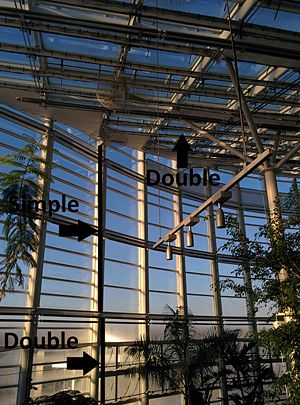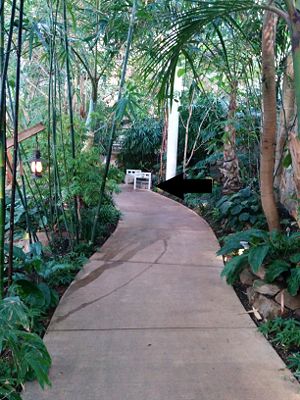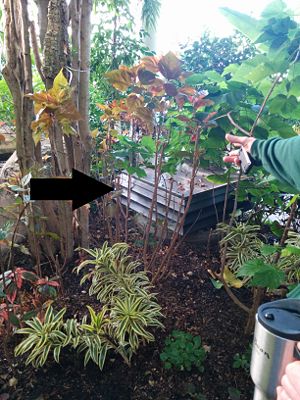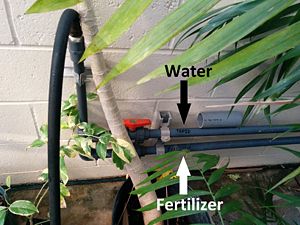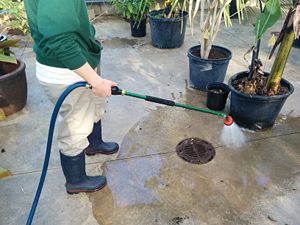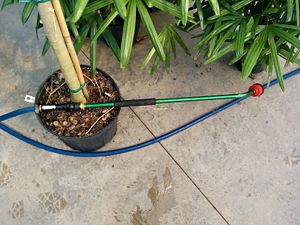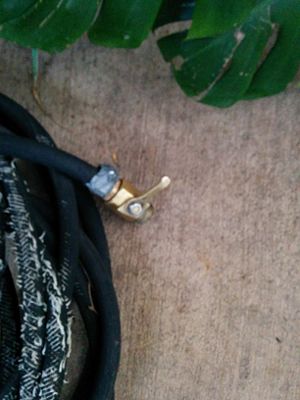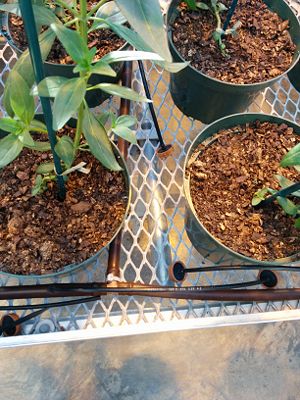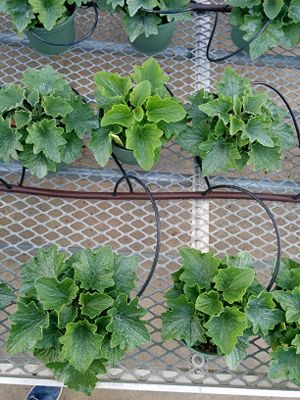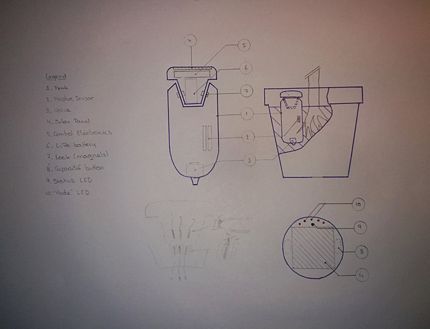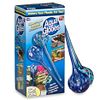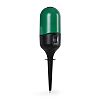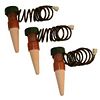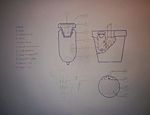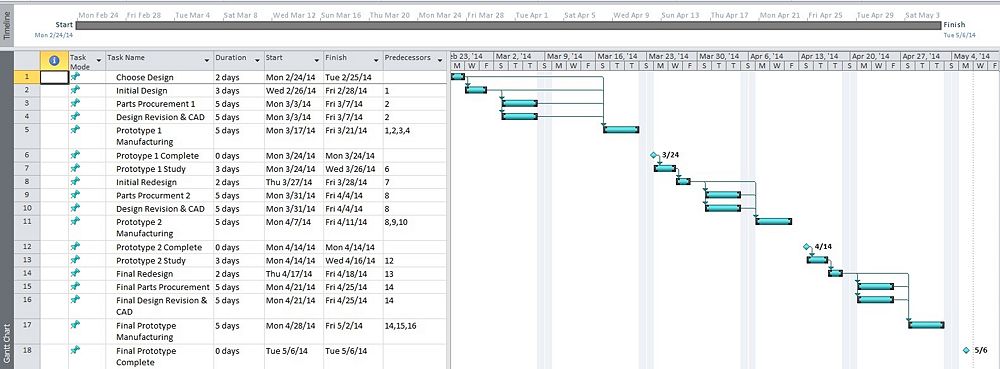Impulse sprinkler opportunity
From DDL Wiki
(→List of at least 100 brainstorming ideas) |
(→Finding and Recommandations) |
||
| Line 293: | Line 293: | ||
=Finding and Recommandations= | =Finding and Recommandations= | ||
| + | =List of 100 ideas= | ||
(Syllabus:Summarize your findings and recommendations. In particular, identify which concept you | (Syllabus:Summarize your findings and recommendations. In particular, identify which concept you | ||
recommend pursuing for the remainder of the semester. Provide a hypothetical before & after | recommend pursuing for the remainder of the semester. Provide a hypothetical before & after | ||
Revision as of 20:49, 23 February 2014
Contents |
Executive summary
Market Study
Add Executive summary for market research here, also discuss top stakeholder needs that arose from this. Points of relevance: -professionals (Phipps) don't use that much of sprinklers -a recurrent issue is that it's not easy to evaluate how much water is effectively available for the plant, how dry are the roots, even harder if in top of that you want to have a dry-moisturized cycle -really good competitors for our sprinkler for only a few bucks more (cf. RainBird sprinklers)->not really usefull to try to improve ours
Expert Interview
Phipp's Conservatory
(DRAFT)
- In a greenhouse, you don’t want to obstruct the sunlight+each plant has different needs -> no sprinkler at the top
- Need “rain” to wash up leaves from dust and insects (the one that plant their mouth inside the vascular tissues ->kill them because it “cut” them since their mouth stays in the leaves and you don’t need too much pesticides
- Sprinklers to prevent cold damage from freezing (5-6 times a year)->cf. apricots and oranges
- Most watering is done by hand
- Automatic watering if all the same plants ->rare, only one room (and rather small) at Phipp’s
- Automatic watering is not aesthetic, and if it fails you can lose precious plants
- When one plant in a whole bunch need a different watering->in a pot
- Air movement is REALLY important (4 reasons):
- plants need some movement -> triggers the plant to have ligments and small internal links -> more resistant
Ex: caoutchouc tree with leaves so heavy that they bend by themselves and break in the middle Short internodes: prettier and stronger plant
- From heating prospective: increases heating efficiency
- More air around the plant to bring the CO2 to the leaves (plants tend (they grow like that) to keep the air inside the leaves -> bushes against wind). Up to 500ppm of CO2 lower if air still -->better plant growth
- To reduce the amount of fungus diseases (stagnant air)
Ex: poinsettias are from the desert of mexico, and in the humid environment they get fungus (white) which spreads really really quickly It’s all about reducing the amount of chemical pesticides, and if you have to replace a full room of poinsettas it’s really expensive (4000$) Ex: fans in the orchid room = 6000$ a year, with 3000$ in the summer that you can’t take of in any casem the 3000$ remaining -> is it worth to lose a whole crop? (cf. poinsettias)
- Heating is conventional steam heating on the walls of the room, behind the wall so that visitors don’t see it. (there is a whole pathway going around the external walls)
- Have to open the vents to renew the air EVEN IN WINTER to cool down the greenhouse, because the .radiators have thermal inertia. ->Computer control system (“ARGUS”) tries to optimize heating to save energy
- No double glass in a greenhouse (so more heat loss), because the exact wavelength plants use is reduced by 20% at each layer of glass->so only one layer of glass
- Fountains, water and others are mainly decorative
- On fridays, everybody waters more because on the weekend there is only a reduced team.
- Insects come from both Pittsburgh and with the plants -> sometime they even find frogs from Florida, those are the one you can hear in one of the rooms of Phipps. they also have birds living there during the winter->doesn’t seem to be a problem, seem even to help by eating the insects and so reducing the amount of pesticides needed.
- Indian forest (warmest room in winter/coolest in the summer): the key is the orientation of the glass:
- Lower (for winter)->simple layer
- Roof (for summer)->double layer
- Bottom: double layer because even in winter the sun is never this low
- Winter: fans shoot the hot air down (heating pipes are on the glass ceiling)
- Summer: fans shutted down->passive cooling: in summer, fresh air is brought from somewhere shady outside and injected in the greenhouse (up to about 5° cooler in the greenhouse than the outside with this system)
Anthropological study
Phipp's Conservatory
(was explaining what they were doing, what was their experience with the product and their feelings about it, and at the same time were doing it)
- Fertilize by switching the source at the connection of the hose -> you lose a lot of water each time
- Hold the HOSE and the bar to operate the jet
- Unscrew the tube (diffuser) to wash leaves and have a stronger water-shoot.
Ask if inconvenient? -> No
- You have to screw and unscrew the hose, the nozzles, everything all the time-> clipping would probably be way more convenient
User interviews
Phipp's Conservatory
Users reports that the most annoying thing is that sometimes it leaks and there is nothing you can do about it on the go.
Orchids and some tropical plants don’t like city water (because of the salts) -> inverse-osmosis (from water they recapture from the greenhouse) But really inconvenient->bringing this water all the way from the orchis house in a big container… And they don’t have too much of that water
Other user: Main complaints about the individuals watering systems and that you cannot monitor how much water have the roots->sometimes it’s completely wet outside but there is no water for the roots…
Watering pots, not convenient:
- long to set up
- when you have different plants on the same table/feeder and they need different watering…
Idea: monitor exactly how much water you have in the roots
Solutions we proposed: water by the table?->moses and algae (big concern the algae), you have to wash it->but they will try two of them soon with water already used They used capillary mats on which the plants are put
Homeowner
The subject of this interview was a middle-aged homeowner. She maintained a grass lawn in her backyard, and planted vegetable gardens in the spring and summer.
Her first major complaint was regarding the distribution of water from a sprinkler. For watering vegetable plants, the spray from most sprinklers is to diffuse, so the user has to stand there holding a hose for the duration of the watering. Some opportunities that arose from this included lighter hoses or hose attachments to make this process more efficient, as well as sprinkler modifications for a less diffuse spray. Her only other complaint was regarding the strength required to dig holes and move dirt during the planting process.
The user didn't have the strength to use a full length shovel, so had to kneel down to use a shorter trowel, which was strenuous on her back. Furthermore, she said that it required a lot of strength to break down any dirt that was packed hard, and it was painful with her arthritis.
Opportunities that arose from this included ways to loosen dirt, as well as ideas about a shovel that would require less strength to use.
Online Reviews
For the sprinkler that we dissected for the first report, the most valuable consumer feedback was available through Home Depot's online customer reviews [1].
The average grade from 43 sprinkler set reviews was 2.3/5. From going through the comments and keeping a tally of reported issues, a few major design flaws with the system became apparent.
- The most common issue, surprisingly, was the supporting stake bending or breaking. Three users reported that the stake broke altogether and another eight complained that it bent when attempting to put it in the ground. This was somewhat surprising because it is made of zinc and seemed to be one of the more sturdy parts of the system.
- The next most common issue, reported by 9 of 43 people who reviewed it, was that the sprinkler would often become stuck instead of rotating. This seemed to be mostly due to the design issue with clip height that was noted in the FMEA analysis in the first report.
- There were also many other issues. Three people said that the sprinkler simply fell apart, and there were seven total reviews with issues stemming from inadequate coverage, including uneven and small coverage areas. Other reviews mentioned leaking, clogging, difficulty with adjusting the settings and making them stay, cracking of the plastic, leaning to the side on wet ground, and spinning off the spike.
In addition, five reviews stated simply that the sprinkler stopped working without going into further detail. The fact that all of these issues came up in just 43 customer reviews shows that there is a lot of room for improvement with this product.
Design concepts (top 3)
(Syllabus:Provide sketches and descriptions of your top 3-5 design concepts, describing what opportunities have been identified and how they will be addressed.)
After three sessions of brainstorming, each of us picked five ideas out of the 100, and then we all voted for those 25 ideas. Out of the 10 remaining, we got rid of five more. We were left with five ideas of project: Water Can Redesign, Automatic underground water dispenser, Slap-Chop dirt loosener, a Hornet Nest Capture System and a Fulcrum Shovel.
After some brainstorming about how to actually implement those ideas, we realized that the Hornet Nest Capture System couldn't be efficient whatever is the way the nest was fixed on the wall/ceiling/corner, and that it would probably be out of the scope of this class to design a system efficient in all those configurations. The fulcrum shovel was eliminated for similar reasons.
We then divided the team in three groups, each assigned to one of the three remaining concepts, to see how to implement them and compare them to existing products.
Water can redesign
Slap-Chop dirt loosener
Automatic underground water dispenser
Design Reasoning
One issue that was pointed out by both professionals (Phipp's Conservatory) and "hobbyist" (flowers store and many others questioned people) is that plants in pot die as often from a lack of watering than from an over watering. And when you water from the top, it can be totally wet but the roots are, in fact, completely dry...
One of the Phipp's employee said that it would be great to have for instance something that you put in the ground and by itself decides whether or not it has to give water, how much, and that would be done directly into the roofs.
The flowers shop owner told us that the aqua globe are great so that people don't forget to water, or over water their plants, but it maintain a constant level of humidity in the soil, and the plant need a cycle dry-humid (depending on the time of the day, the season, the temperature, the lighting...)
We addressed this need with an automatic (underground) water dispenser. Powered by small solar panels and a small Lithium-Ions rechargeable battery, with a very simple interface (say on a scale from 1 to 5 how much water this type of plant needs) and sensors (moisture sensor at least, but we could add sensors for temperature external/internal, light, external humidity...) a small micro-controller (probably based on an Arduino for the prototype) would act on a valve to dispense water when the plant needs it, and where the plant needs it, i.e. the roots, and with the appropriate cycle.
Design Description
Our design consists of a tank of water, in the soil of the pot ("underground") or even built-in the pot (for obvious aesthetic purposes, even if it would be possible to make for instance a really design glass water tank), on which the stopper would consist of the assembly solar panel- control electronics (c.f. drawings for more details)
The design is such that you only need to buy one cap (the most expensive part), and you can buy tanks of different volumes for low price (less that 5$). By such providing, at relatively low cost, a wide variation of colors, functions, and water tank sizes, the product could be diversified to satisfy each client, who will probably be someone living in the city and travelling at least once a year, with only a few interior plants, giving much importance to the aesthetic, even if more expensive, and not really inclined to spend a lot of time maintaining those potted plants.
The main challenges in the conception of the realization design would be to have:
- A convenient an efficient way to connect electrically the stopper to the tank, since the stopper has to be removed to fill the tank and holds the electronic. It also has to be put on and off easily (For instance with a magnetic lock)
- Low power valve
- How to embed the different electrical components and cable into the tank to reduce costs
- Create a simple user interface water-resistant
Relevant competitor products and Patents
- Aquaglobes: A bulb full of water keep the moisture level constant in the soil by letting water go out when the soil is dry
- Inovalley AA02 Automatic Water Dispenser for Plants
- Ceramic Watering Probes
- Most relevant Patent: Self-contained automatic plant watering apparatus system and method for operating same US 20130205662 A1
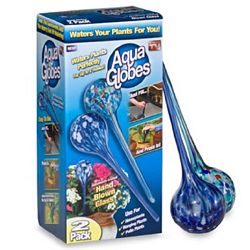 Aquaglobes (Source:Amazon.com website) |
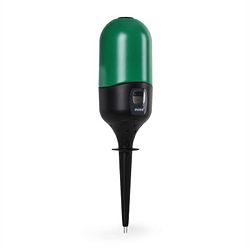 Inovalley AA02 Automatic Water Dispenser for Plants (source: hifi-tower.co.uk) |
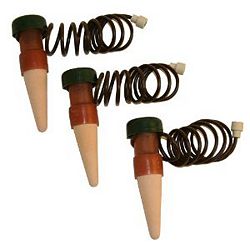 Ceramic Watering Probes 6001-TC (Source:Amazon.com website) |
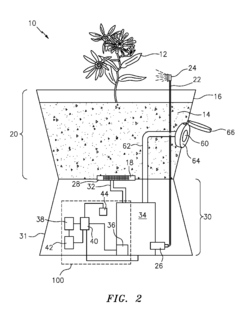 Self-contained automatic plant watering apparatus system, (Source: US Patent 20130205662 A1) |
Pugh Chart
The Pugh Chart compares our design to the existing concurrent products presented before, with as Datum the Aqua Globe.
| Description | Standard: Aquaglobe | Inovalley AA02 Automatic Water Dispenser | Ceramic Watering Probes | Automatic underground water dispenser | |
|---|---|---|---|---|---|
| Sketch | |||||
| Criteria | weight | Datum | Competitor 1 | Competitor 2 | Design |
| Durability | 1 | 0 | + | - | + |
| Aesthetics | 3 | 0 | 0 | - | ++ |
| Time between refills | 2 | 0 | 0 | ++ | + |
| Affordability | 2 | 0 (8$ p.) | -- (48$ p.) | 0 (7$ p.) | -- (~20$ p.) |
| "Quality" of watering (cycles...) | 2 | 0 | ++ | 0 | ++ |
| Complexity (manufacturing) | 1 | 0 | -- | - | -- |
| Ease of integration | 1 | 0 | 0 | 0 | - |
| Easy to use | 2 | 0 | + | 0 | + |
| + | 0 | 7 | 4 | 15 | |
| 0 | 7 | 3 | 2 | 0 | |
| - | 0 | 7 | 5 | 7 | |
| Net score | 0 | 0 | -1 | 8 | |
Gantt Chart
A Gantt chart is provided below, mapping out the team schedule for design and manufacturing of the three prototypes for the remainder of the semester. A generous amount of time is given over to parts procurement, due to this section being the most likely to have unexpected delays. The Gantt chart was made using Microsoft Project 2010. The 1 week break during the first prototyping phase where nothing is scheduled is for spring break.
Team member roles
Hira Ahmad: Team Leader/User and expert interviews/Snap-Chop dirt loosener
William Bullard: User and expert interviews/ Customer Reviews/ Slap-Chop dist loosener
Louis Dufour: Wiki Leader/Phipp's Interview/ Underground automatic water dispenser
Tristan Greiner: Phipp's Interview/ Water can redesign
Justin Hui Bon Hoa: Gantt Chart/ Water can redesign / User Interview
Finding and Recommandations
List of 100 ideas
(Syllabus:Summarize your findings and recommendations. In particular, identify which concept you recommend pursuing for the remainder of the semester. Provide a hypothetical before & after user scenario representative of your target market from your research findings to motivate your top solution concept)
| Sprinklers | Other Outdoor Gardening | Professional Gardening | Indoor Gardening |
| Roomba Sprinkler | Tiny Hose | Fertliilzer Hose Attachment | Fertilizer Sensor for hydroponic garden |
| Improved Sprinkler - overall redesign | Gallon Readout (attached to hose nozzle) | Dual Hose System for Fertilizer | Indoor UV Lamps, focused glow |
| Pressure Regulated Plant Drippers | Retractable Housing | Water level sensor | Adaptative bottleneck flower vase |
| Antler System | Click Lock for Hose, instead of screwed in | Use quartz instead of glass in the greenhouses | Watering can Redesign |
| Retractable sun roof/showerhead | Automatic water turnoff when unclipped | Space: electrostatic assited watering because of low gravity | Filter your own water at home with plants since the city water is disgusting |
| Underground watering system | Adapter or hybridization for above | Animal belly seed dispenser | pencil sharpener that turns shavings into fertilizer |
| Wind-up roomba sprinkler | Rainwater Recycling | Diameter varying flower pot. | |
| Water powered roomba sprinkler | Automatic undeground water dispenser | Pot with built in undersoil aquaglobes | |
| Sprinkler stand instead of stake | Trowel with dirt loosener | ||
| Gallon readout with automatic cutoff | Green paint | ||
| Sprinkler with sensor to turn on. | Lawnmower sprinkler (zamboni) | ||
| Preset tank for sprinklers - can fill to desired volume and will not over or underwater | Gutter Cleaner | ||
| Automated sprinklers based on rain levels | All-in-one gardening vehicles | ||
| Flying Drone sprinkler | Grass clipping grinder | ||
| Lawnmower powered by water going out of the tip of the blades | Helium Balloon carrier. | ||
| Lots of really tiny porous hoses in the ground under the grass | Slap-chop dirt loosener | ||
| System to prevent riding mower overlap | Vacuum Shovel | ||
| Fulcrum Shovel | |||
| Ultimate Roomba | Electric cables in hose/sprinkler | ||
| Underground porous big pots full of water | UV Lamps | ||
| Swivel sprinkler | No Farmer's Tan Shirt | ||
| Energy harvester sprinkler | Aerator + fertilizer combo | ||
| Sprinkler attached to river/pond | Automatic undeground water dispenser | ||
| Sprinkler on the top of a tall tree or stick | Compact Lawnmower for slopes | ||
| Laser Grass Cutter | |||
| Ghetto Roomba | |||
| High Pressure Water to cut grass | |||
| Boomerang Blade | |||
| Seed Guiadnce System | |||
| Magnetic lock for hose | |||
| Pedal Powered Lawnmower | |||
| Wheelbarrow redesign | |||
| High Frequency Speaker for Animals | |||
| Compost Bin Aerator | |||
| Compost Railroad System | |||
| Hedge Shredder | |||
| Laser guided hedge trimmer | |||
| Hornets Nest Capture - sharp square bucket | |||
| Bayblade Lawnmower | |||
| Long term fertilizer | |||
| Ipad Lawnmower Fix | |||
| Calorie Counting Lawnmower | |||
| Spray kinda paint at the base of your plants in your vegetable garden so not to have weeds growing | |||
| Weeding robot | |||
| Underground net to prevent rodent from getting in the garden | |||
| Wall hanging table garden | |||
| Catapult for fertilizer/seeds | |||
| Seeds gun | |||
| Vacuum for water | |||
| Squirrell killing laser robot | |||
| vacuum rake to collect leaves as they are being raked | |||
| Lawn Cover for cars | |||
| tree shaker | |||
| Emergency watering explosion system | |||
| Temporary collapsible greenhouse | |||
| Small rubber balls in pipes | |||
| Rolling leaf collector | |||
| Large leaf collecting net | |||

